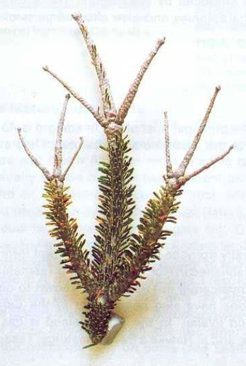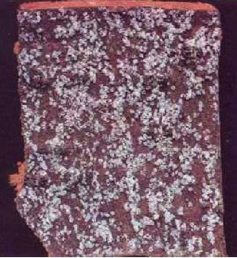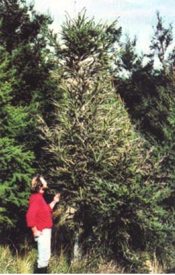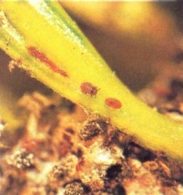PESTS AND DISEASES OF FORESTRY IN NEW ZEALAND
Fir adelgid
Scion is the leading provider of forest-related knowledge in New Zealand
Formerly known as the Forest Research Institute, Scion has been a leader in research relating to forest health for over 50 years. The Rotorua-based Crown Research Institute continues to provide science that will protect all forests from damage caused by insect pests, pathogens and weeds. The information presented below arises from these research activities.
Forest and Timber Insects in New Zealand No. 52.
Fir adelgid
Revised 2009
Based on R. Zondag (1982)
Insect: Adelges nordmannianae (Eckstein)* (Hemiptera: Aphidoidea: Adelgidae)
* Also known as Dreyfusia nusslini Börner or Adelges nusslini (Börner)

Fig. 1 - Branchlet of Caucasian fir swollen and deformed after attack by the fir adelgid.
Type of injury
Sapsucking activity by the fir adelgid can cause loss of vigour in and sometimes death of a tree. Insertion of the insect’s stylet mouthparts into the plant tissues provokes abnormal cell growth, which in turn blocks normal water conduction and causes trees heavily attacked over several years to suffer severe loss of foliage or produce stunted, often discoloured, shoots and needles. Occasionally branchlet tips become swollen and deformed (Fig. 1). Trees under stress, such as those growing in poor or shallow soil or affected by drought, seem to be the most susceptible.
When populations are low the insects are usually found on the ends of shoots but as their numbers increase they colonise twigs, branches, and main stems. Infestation, which persists for several years, can be recognised by the waxy white threads produced by the insects. These threads form a dense woolly cover over the colonies and give affected parts of the tree a greyish appearance (Fig. 2).
Hosts
In New Zealand the principal host of the fir adelgid is Abies nordmanniana (Caucasian fir) but it is sometimes found on other Abies spp.
Distribution
This insect, originally from the Caucasus, is present throughout Europe and has also become established in North America and Tasmania. It was first found in New Zealand in Invercargill in 1954 and is now found throughout much of the country although they are no records north of Taupo or on the west coast of the South Island.
Economic importance
Although infestation by the fir adelgid can cause the defoliation, disfiguration (Fig. 3), and death of ornamental and parkland trees, the economic importance of this insect is slight since Abies (firs) are rarely used as plantation trees in New Zealand.

Fig. 2 - Fir adelgids are under the woolly secretion on this piece of bark from Caucasian fir.

Fig. 3 - Caucasian fir disfigured and stunted by the fir adelgid. (The branchlet shown in Fig. 1 was from this tree.)
Description, life history, and habits
The Adelgidae, which are closely related to the aphids, occur only on conifers. In Europe and North America most species have complicated life histories which usually involve hosts of two different genera: a primary host, Picea (Spruce), and an alternate or secondary host, which according to the species of adelgid involved may be Abies, Larix (larch), Pinus (pine), Tsuga (hemlock), or Pseudotsuga menziesii (Douglas fir). On both primary and secondary hosts several different forms of the one adelgid species can occur, while winged forms migrate from one type of host to another. In New Zealand, though, the life cycle of A. nordmannianae appears restricted to the secondary host, since the species has been found only on Abies. Apart from host preference, the life history and habits of A. nordmannianae in New Zealand are similar to those of Pineus pini (Macquart), the one other adelgid known to be established here but occurring only on pines (see Leaflet No. 25).
The usual form of the fir adelgid in New Zealand is wingless. The adult is approximately 1 mm long, rounded in shape, and strongly convex. It is purplish-brown, with the head and thorax being slightly darker than the abdomen. Only by using a microscope can the six legs, minute antennae, and fine hair-like mouthparts be seen. On the upper surface of the head, thorax, and abdomen there are groups of glands which produce the waxy-like filaments which cover the insect.
Throughout the year the wingless forms reproduce parthenogenetically, i.e. eggs hatch without fertilisation. Only females are produced. The young, or “crawlers” (Fig. 4), which hatch from the eggs wander about and may be blown by the wind or carried on birds to other trees. They eventually find a suitable spot to insert their mouthparts and start sucking sap. The insect moults three times before it reaches adulthood. Development from egg to adult takes only a few weeks, and several overlapping generations are produced in a year.
In early summer a form of crawler which always settles on the leaves of flushing shoots may be produced. This type of crawler passes through four moults and becomes either a winged or wingless adult which remains on Abies to lay eggs. The crawlers which hatch from these eggs develop into adults of the usual wingless form. A second type of winged female, which in the Northern Hemisphere flies away to reproduce on Picea orientalis (oriental spruce), has never been found in New Zealand.

Fig. 4 - Two juvenile fir adelgids on needle of Caucasian fir. The dark, oval object immediately below them is an adult fir adelgid.
Control
Ornamental and parkland trees may be sprayed with insecticides recommended for sapsucking insects. Very few predatory lacewing and ladybird larvae are present on colonies of this insect. The main predator of P. pini, the larvae of the introduced fly Neoleucopis tapiae Blanchard (Chamaemyiidae), has never been found on material infested by the fir adelgid.
Bibliography
Davies, J.M. 1968: Adelgids attacking spruce and other conifers. Forestry Commission Leaflet No. 7. HMSO, London. 12 p.
Varty, I.W. 1956: Adelges insects of silver firs. Forestry Commission Bulletin No. 26 . HMSO, Edinburgh. 75 p.
Zondag, R. 1982: Adelges nordmannianae (Eckstein), (Hemiptera: Aphidoidea: Adelgidae). Fir adelgid. New Zealand Forest Service, Forest and Timber Insects in New Zealand No. 52 .
This information is intended for general interest only. It is not intended to be a substitute for specific specialist advice on any matter and should not be relied on for that purpose. Scion will not be liable for any direct, indirect, incidental, special, consequential or exemplary damages, loss of profits, or any other intangible losses that result from using the information provided on this site.
(Scion is the trading name of the New Zealand Forest Research Institute Limited.)

 Farm Forestry New Zealand
Farm Forestry New Zealand

